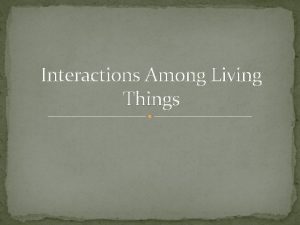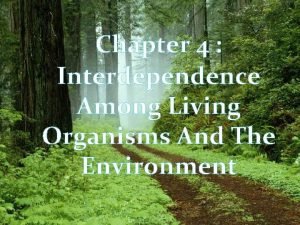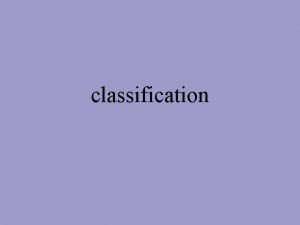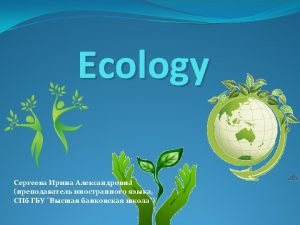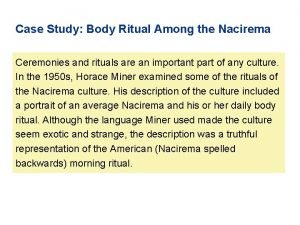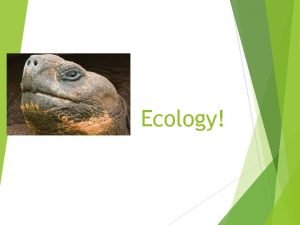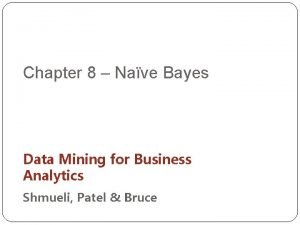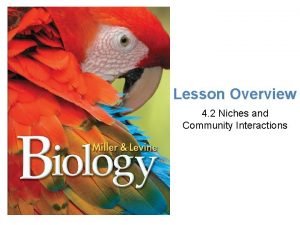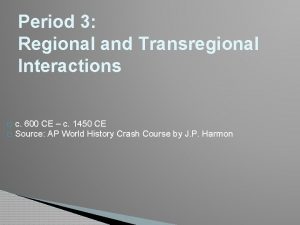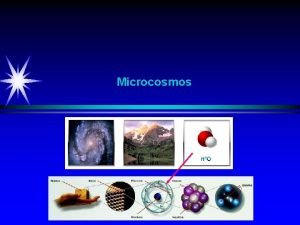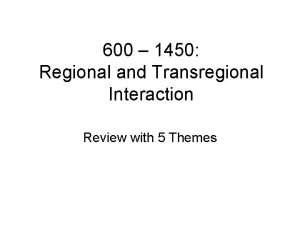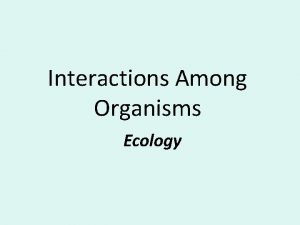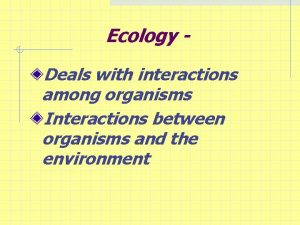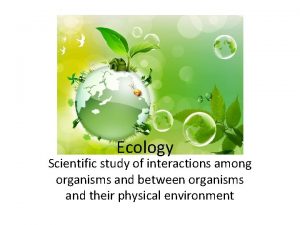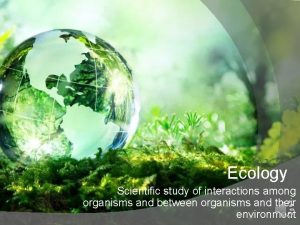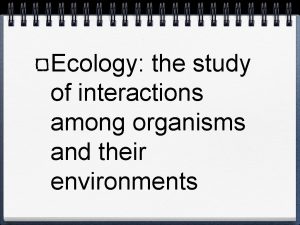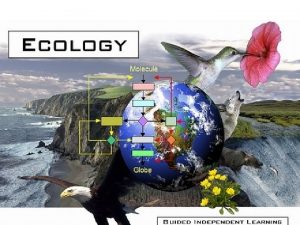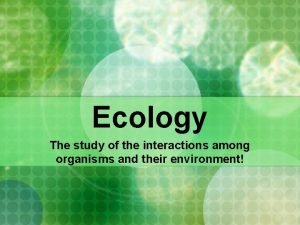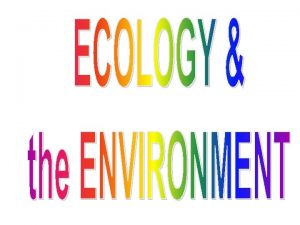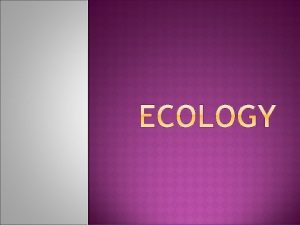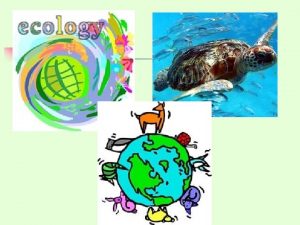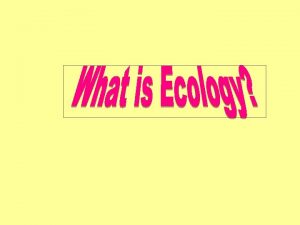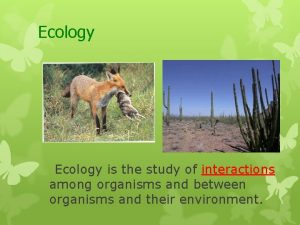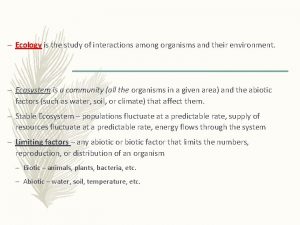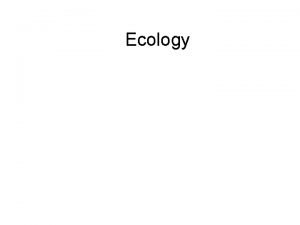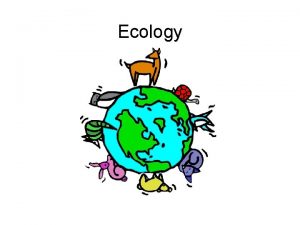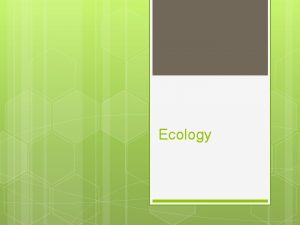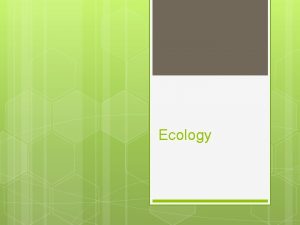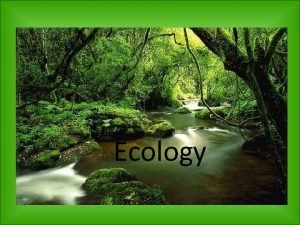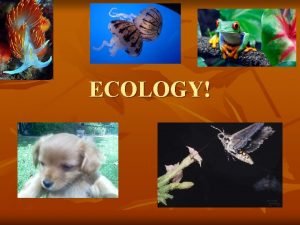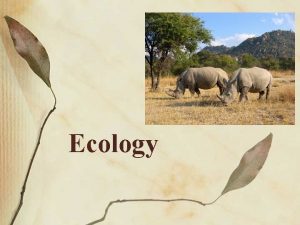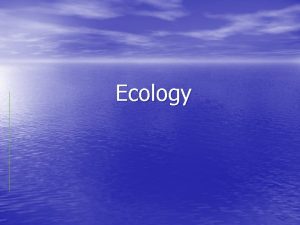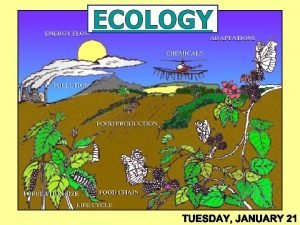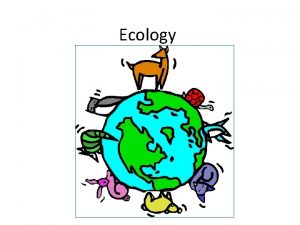Ecology The study of interactions among organisms and


















































- Slides: 50

Ecology

The study of interactions among organisms and between organisms and their environment.

Biosphere

• the combined portions of the planet in which life exists, including land, water, and air or atmosphere.

Species

• a group of organisms so similar to one another that they can breed and produce fertile offspring

Population

• groups of individuals that belong to the same species and live in the same area.

Community

• assemblages of the different populations that live together ina defined area

Ecosystem

• a collection of all the organisms that live together in a particular place as well as their nonliving or physical environment.

Biome

• a group of ecosystems that have the same climate and similar dominant communities. Desert Tropical rain forest

Autotroph

• use energy from the environment to fuel assembly of simple compounds into complex organic molecules. • Also called Producer • harness the power of the sun through photosynthesis • use chemical energy to make carbohydrates.

Heterotrophs

• Organisms that rely on other organisms for their energy and food. • Also called Consumers • Can be herbivores, carnivores or ominivores

Herbivores

• obtain energy by eating plants.

Carnivore

• Organisms that eat other animals.

Omnivore

• Organisms that eat both plants and animals.

Detritovores

• Organisms that feed on the remains of plants, animals and other dead matter. bacteria fungi

Decomposers

• Organisms that breaks down organic matter. • Fungi • Bacteria • Recycle carbon back into the environment

Food Chain

• a series of steps in which organisms transfer energy by eating or being eaten. • Each step in a food • chain is called a trophic • level. Producers make • up the first step, • consumers make • up the higher levels.

Food Webs

• show the complex interactions within an ecosystem. • Each step in a food web is called a trophic level. Producers make up the first step, consumers make up the higher levels.

Competition

• When there are more than one organism utilizing the same environment and resources. One usually becomes dominant

Symbiosis

• Two or more species interact in permanent relationships. - mutualism - parasitism - commensalism

Mutualism

• Interactions between organisms that benefits both. • Ex: Flowers and their pollinators

Commensalism

• One species does not harm or help another Ex: barnacles on a whale

Parasitism

• Beneficial to the parasite , but harms the host. Ex: Tapeworm in cattle

Coevolution

• Long term evolutionary adjustments of species to one another. Ex. A flower pollinated by a bat

Ecological Pyramid

• a diagram that shows the relationship amounts of energy or matter contained within each trophic level in a food web or food chain.

Energy Pyramind

• 10% of the energy available within one trophic level is transferred to organisms at the next trophic level. Trophic levels

Succession

Primary Succession the development of plant and animal life in an area without topsoil; the development of biotic communities in a previously uninhabited and barren habitat with little or no soil. Secondary succession the series of community changes which take place on a previously colonized, but disturbed or damaged habitat. Examples include areas which have been cleared of existing vegetation (such as after tree-felling in a woodland) and destructive events such as fires.
 Abiotic factor
Abiotic factor Congress formal and informal powers
Congress formal and informal powers Interactions among living things
Interactions among living things Section 1 organisms and their relationships
Section 1 organisms and their relationships Principles of ecology organisms and their relationships
Principles of ecology organisms and their relationships Multicellular unicellular
Multicellular unicellular Levels of organization in the biosphere
Levels of organization in the biosphere Types of living organisms
Types of living organisms Member of the same species
Member of the same species In the hierarchy of classification which grouping
In the hierarchy of classification which grouping Organisms taxonomy
Organisms taxonomy Ecology study guide answers
Ecology study guide answers Chapter 3 section 1: community ecology answer key
Chapter 3 section 1: community ecology answer key Ecology is the study that helps to preserve
Ecology is the study that helps to preserve Accounting information system chapter 1
Accounting information system chapter 1 Body ritual among the nacirema ethnocentrism
Body ritual among the nacirema ethnocentrism Findings of qualitative research
Findings of qualitative research Money market graph expansionary monetary policy
Money market graph expansionary monetary policy Properties and interactions of magnets
Properties and interactions of magnets Geosphere examples
Geosphere examples 6.1 habitats niches and species interactions
6.1 habitats niches and species interactions Integral product architecture example
Integral product architecture example Factors influencing communication process
Factors influencing communication process Symbiosis and species interactions keystone webquest
Symbiosis and species interactions keystone webquest Naive bayes pays attention to complex interactions and
Naive bayes pays attention to complex interactions and Integral vs modular architecture
Integral vs modular architecture Niches and community interactions
Niches and community interactions Regional and transregional interactions
Regional and transregional interactions Microcosmos macrocosmos
Microcosmos macrocosmos Regional and transregional interactions
Regional and transregional interactions Hát kết hợp bộ gõ cơ thể
Hát kết hợp bộ gõ cơ thể Bổ thể
Bổ thể Tỉ lệ cơ thể trẻ em
Tỉ lệ cơ thể trẻ em Voi kéo gỗ như thế nào
Voi kéo gỗ như thế nào Tư thế worms-breton
Tư thế worms-breton Hát lên người ơi
Hát lên người ơi Các môn thể thao bắt đầu bằng tiếng nhảy
Các môn thể thao bắt đầu bằng tiếng nhảy Thế nào là hệ số cao nhất
Thế nào là hệ số cao nhất Các châu lục và đại dương trên thế giới
Các châu lục và đại dương trên thế giới Công thức tính thế năng
Công thức tính thế năng Trời xanh đây là của chúng ta thể thơ
Trời xanh đây là của chúng ta thể thơ Cách giải mật thư tọa độ
Cách giải mật thư tọa độ Phép trừ bù
Phép trừ bù Phản ứng thế ankan
Phản ứng thế ankan Các châu lục và đại dương trên thế giới
Các châu lục và đại dương trên thế giới Thể thơ truyền thống
Thể thơ truyền thống Quá trình desamine hóa có thể tạo ra
Quá trình desamine hóa có thể tạo ra Một số thể thơ truyền thống
Một số thể thơ truyền thống Cái miệng nó xinh thế
Cái miệng nó xinh thế Vẽ hình chiếu vuông góc của vật thể sau
Vẽ hình chiếu vuông góc của vật thể sau


